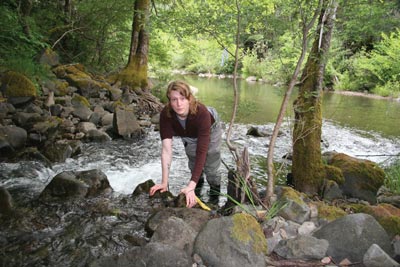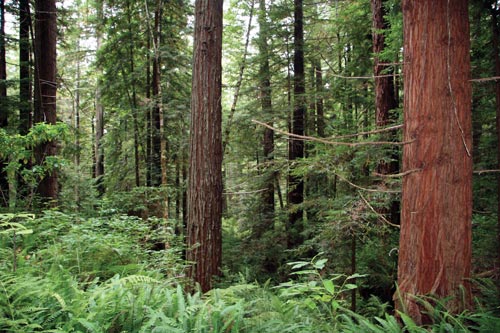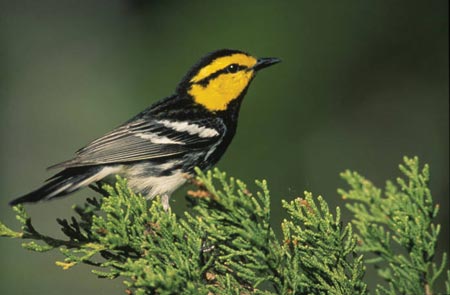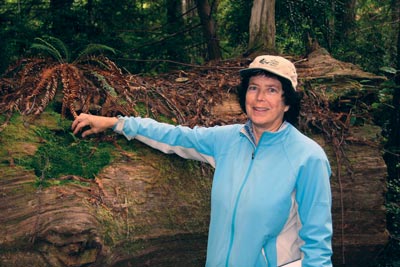What can landowners do to protect the threatened and endangered species
that make their homes on private land?
By Jane Braxton Little
Laurie Wayburn stands quietly in a forest glade surrounded by towering coastal redwoods. A breeze wafts the five-fingered ferns at her feet and ruffles the flat needles in the branches overhead. Wayburn closes her eyes, tilts her head and listens.
For 10 consecutive years, she has heard the raspy hoots of northern spotted owls from this site at Van Eck Forest, near Arcata on the northern California coast. Last year, she detected both a male and female. The presence of this endangered species, the focus of a decade of timber wars, has inspired her to develop management innovations that restore habitat and watersheds while producing high-quality timber.
“It’s our responsibility as landowners to come up with solutions so these species are there for our kids,” says Wayburn, president of Pacific Forest Trust, which manages the 2,200-acre forest. Lately, however, no one has heard the Van Eck spotted owls — not for months.
The silence here resonates ominously across the country. From Maine to Arizona, America’s forest species are in a steady slide towards extinction. Scientists predict that more than 4,600 native plant and animal species will be gone by 2030, an evolutionary blink of the eye. They join species worldwide that are currently disappearing at as much as 1,000 times the expected natural rate. More than 40 percent of the world’s amphibians are threatened along with 25 percent of mammal species, according to a 2010 study coordinated by the International Union for Conservation of Nature. The list of the doomed varies from grizzly bears and other wide-ranging megafauna to etonia rosemary, a member of the mint family limited to two remote sites in northeastern Florida when it was discovered. Losses are projected in forest watersheds across the lower 48 states, but they are expected to hit the Appalachian Mountains and southeastern region particularly hard according to a recent “Forests on the Edge” report for the USDA Forest Service. Here, habitat lost to housing development is placing up to 90 percent of the local species at risk, says co-author Susan Stein, a researcher with the agency’s Cooperative Forestry staff.
The burden of keeping threatened species alive rests heavily on private forest owners. From multi-thousand-acre stands to modest mom-and-pop operations, private timberlands in the lower 48 states harbor 60 percent of the forest species scientists expect to decline or disappear within the next 20 years. Making a living has never been easy for these landowners, who hold 35 percent of all forestland. Today, they face a disproportionate responsibility for the future of thousands of wildlife species.
Historically, forest owners have not welcomed at-risk species on their property. They viewed endangered plants and animals as a potential management expense and a threat to their land values. Following passage of the 1973 Endangered Species Act, some landowners actively destroyed habit in a response dubbed “shoot, shovel and shut-up.” By increasing timber harvest rotations and cutting younger trees, they could discourage — even eliminate — old-growth dependant species such as the red-cockaded woodpecker or Florida panther.
Today, a variety of programs offer incentives for conserving wildlife. Conservation easements, in use since the 1930s, are permanent agreements that restrict future activities on the land to protect its conservation values. The landowner sells or donates the development rights to a land trust, often qualifying for additional income through a tax reduction. More than a dozen federal conservation programs assist forest owners with improving forest health, soil and water quality. Some offer technical assistance, some funding. At least 16 states have tax credits or other incentives for forest owners to steward their land. These programs are designed to encourage long-term conservation, including at-risk species management.
Discovering an endangered species has a definite impact on forest management, but it doesn’t have to put a stop to productivity, says Ted Beauvais, assistant director of Co-operative Forests for the USDA Forest Service. Incentive programs can help alleviate the burden of timber harvest restrictions due to an at-risk species. “Most forest landowners want to be good stewards and obey the law,” Beauvais says. “I have to believe their efforts will make a difference.”
RETAIN, SUSTAIN & GAIN
For Wayburn, managing forests for endangered species and enjoying economic returns are wholly complementary. The old paradigm was choosing between following the traditional economic model or managing the forest as a park — “a choice between rape and chastity,” she says. Van Eck Forest is pursuing a third path: management that works for conservation and makes it a contributor to the economic bottom line.
Wayburn walks along a two-track path under a canopy of redwoods and Douglas firs. The soil is moist and spongy. Banana slugs cling to ferns beside trunks streaked with black bear scratches. Chainsaws whine in the distance. All of Van Eck Forest is protected by a conservation easement that guides forest management, allowing sustainable logging but prohibiting development. The easement gives Wayburn the ability to harvest saw logs and to thin stands for future logging with the confidence that she can continue to plan for-profit activities without getting shut down by endangered species regulations.
Recently, she entered into a Safe Harbor Agreement with the U.S. Fish and Wildlife Service that rewards Van Eck for restoring spotted owl habitat. In exchange for contributing to owl recovery, the agreement removes barriers to future operations. That gives Wayburn the additional certainty to harvest timber and manage the forest without fear of further federal restrictions. Van Eck is producing between 15,000 and 18,000 board feet per acre, and the volume is going up with every harvest.
Along with logging, Van Eck earns income by reducing carbon emissions. It is the first emissions reductions project registered under the state forest protocols designed to help California meet its ambitious goals for decreasing greenhouse gases. Industries and other sources that emit more carbon dioxide than allowed pay Van Eck for storing carbon in trees and soil. Depending on the market, the forest often earns more income from carbon than sawlogs.
The synergy between economics, habitat restoration and climate can tip the financial balance for landowners everywhere, Wayburn says: “This is not boutique forest management. Anybody can take advantage of what we’re doing on Van Eck. It’s suitable for anyone who wants to be in forestry for the long term.”

Two hundred miles to the south, The Conservation Fund is taking a similar approach to managing Garcia Forest. The 24,000-acre redwood and Douglas fir forest had been heavily cut by 2004, when the Virginia-based fund bought it. The long-term goal is to create a sustainable forest, protected from development by a conservation easement. While restoring the redwood stand, the fund is harvesting smaller trees to pay for forest upkeep and provide local jobs. It is also earning income through carbon storage as the second and largest forest registered in California’s climate change program.
Since the fund began managing the Garcia watershed, scientists have been finding endangered and unusual species in streams and forest openings. Jennifer Carah, a field scientist, was doing a routine snorkel in a tributary to the Garcia River when she beheld a mass of juvenile coho salmon wriggling in the cold coastal stream. The endangered anadromous fish had not been seen there in decades. This summer, Carah found coho in numerous creeks where scientists had placed wood jams to increase stream complexity and attract salmon. Another rare find on the Garcia is the coastal tailed frog, spotted by an aquatic biologist in 2009. The inch-long amphibian dragging quarter-inch genitalia had never been seen that far south in California’s coastal watershed. And in July, botanists found two rare clovers, one of them on the federal endangered list.
These discoveries are exciting, says Evan Smith, the fund’s vice president for forest land acquisitions and finance. But he’s hesitant to attribute them to recent forest management. “The land is resilient,” he says. “If we just give it a chance, it’s more dynamic and complicated than we think.”
TOO LITTLE, TOO LATE?
Like other forest managers, Evans worries about whether private forests can conserve enough habitat soon enough to make a difference to at-risk species.
Landowners are under even more pressure today than they were when Congress passed the Endangered Species Act. For the last two decades, the United States has been losing more than a million acres of timberland a year, an astonishing average of nearly two acres a minute. The Forest Service projects that more than 57 million acres of private forests — an area bigger than all of New England — will experience significant increases in development in coming decades, further endangering rare species.

Globally, logging and forest loss account for a whopping 17 percent of greenhouse gas emissions — more than from all planes, trains and automobiles on Earth. Cutting trees reduces the amount of carbon naturally stored in their leaves, trunks and root systems, while burning forest fuels actively contributes to emissions.
In the United States, the dramatic decline in timberlands is primarily due to development: housing, schools, shopping centers and parking lots to meet the demands of a growing population. Wildfire, insects and disease are also taking a toll on the habitat available to at-risk species. The collapse of the housing industry over the last three years has offered some respite from the unprecedented losses earlier this century, creating a window for conservation. Several of the largest recent forest transactions nationwide have been for conservation, including the 320,000 acres of the Montana Legacy (see American Forests, Winter 2009) and 105,000 acres in New York’s Adirondacks.
Development pressure hasn’t died; it’s just gotten very quiet, says Peter Stein, managing director of the Lyme Timber Co., a New Hampshire-based investment firm focused on lands with conservation values. “You’d have to be a little crazy to be optimistic, but we are seeing land trusts conserve a great deal of land,” Stein says.
No one expects the development lull to last. Conservation groups nationwide are focused on protecting critical ecosystems that increase the scale of the lands they protect. In the process, they are developing innovative alliances and programs.
In Texas, a partnership among ranchers, Environmental Defense Fund and the U.S. Army began as an effort to protect the golden-cheeked warbler in six central Texas counties. Today, it encompasses 30 counties — a total of approximately 20 million acres — and provides habitat to the black-capped vireo as well as the warbler. Fort Hood, the nation’s largest Army base, is home to 5,000 pairs of endangered golden-cheeked warblers, around 50 percent of the known population of the only bird that nests exclusively in Texas.

Army officials have conserved as much warbler habitat as possible on the base. With active warfare increasing the pressure for live-fire training, they began looking for a way to invest in conservation outside the base to use some of the base habitat for training. The result is the Recovery Credit System, a unique multi-partner program designed to expand warbler protections on adjacent private lands. Landowners with eligible habitat bid to put their land into 10- to 25-year conservation lease agreements managed for the warbler. Fort Hood buys the lease, which provides landowners with a new income source. Much like the carbon storage program in California, the Army earns “credits” that offset the impacts of using warbler habitat for short-term training on the base.
The program appeals to landowners because it brings in revenue but does not commit their land to the permanent limits of a conventional conservation easement, says David Wolfe, a senior scientist with Environmental Defense Fund. As a market-based approach, the Recovery Credit System has potential in other parts of the country. It has attracted developers in Utah, confronted with managing the threatened Utah prairie dog, and Camp Lejeune, a Marine base in North Carolina, where longleaf pine habitat hosts the endangered red-cockaded woodpecker and the threatened gopher tortoise. “We’re confident this approach gets us the scale we need to positively impact species,” Wolfe says.
IF WE BUILD IT…
The many programs offering incentives for land conservation are having an effect. The number of conservation easements has exploded from around 28,000 acres in 1980 to nearly 18 million acres today. The American Forest Foundation tallies 3.5 million acres of private forestland improved or conserved in 2010. Still, the number of landowners who participated in one of the programs available totaled just one percent of America’s 10 million family forest owners. And while these incentives are clearly helpful, they may not always be available.
In an increasingly polarized Congress, some legislators are challenging the Environmental Protection Agency, which enforces many environmental regulations including the Endangered Species Act. Others are threatening to slash or eliminate funding to conservation programs.

In areas where deforestation has taken a devastating toll on habitat, the most effective conservation is sometimes the most direct: digging holes and planting trees. Since 1990, American Forest’s Global ReLeaf program has planted nearly 40 million trees to restore forest ecosystems. Some of them are in the Michoacán highlands of Mexico, host to monarch butterflies. After flying some 3,000 miles from Northeastern United States and Canada to central Mexico, the monarchs winter in local oyamel fir and conifer trees. By the early 1990s, this habitat was largely cut over, replaced by plowed fields and bare slopes (see American Forests, Winter 2009). The deforestation was so threatening to the winter hibernation habitat that the North American monarch migration has been classified as an endangered biological phenomenon.
Recognizing a potential crisis, in 1997, the La Cruz Habitat Protection Project (LCHPP) began distributing trees to small landowners and communities. It has planted more than five million native cedars, oyamel firs and six species of pines, nearly one million of these through support from American Forests. What’s good for the butterflies is just as good for local landowners, says Sue Sill, executive director of LCHPP. The subsistence farmers, who have lived among the butterflies for many generations, are enjoying multiple benefits from the trees they are planting: stabilized soil,
a higher water table and income from timber sales.
“We measure success in what we see,” says Sill. “The mountains are becoming greener. The butterflies are thriving. The landowners and communities are pleased.”
Improving forest habitat here and across the United States offers some respite for at-risk species. However, as human populations continue to grow and development consumes more forestlands, success will require an even greater long-term commitment. It will require innovative management and partnerships. And it will require patience.
Wayburn still has not heard a northern spotted owl hoot from the Van Eck redwoods this fall. That doesn’t disturb her. After a century of logging with little regard to the habitat for these and other forest species, restoring complexity to Van Eck Forest will take time, she says. She is confident that reinvesting profits from logging and carbon storage will gradually return the land to a place where owls will feel welcome.
“The owls will be back,” Wayburn says with certainty. And the endangered, elusive marbled murrelet? “Yes! In a hundred years.”
Jane Braxton Little has published stories in Audubon, Scientific American and Utne Reader.
She writes from Plumas County, California.


